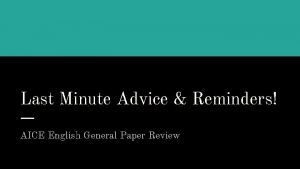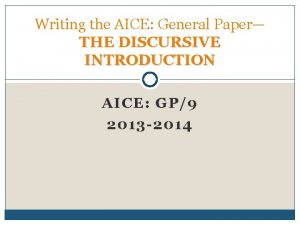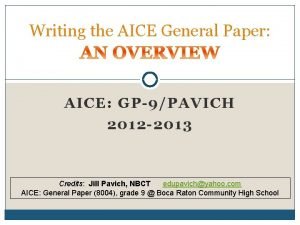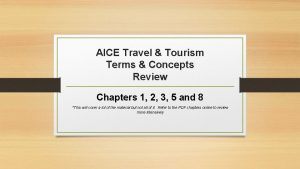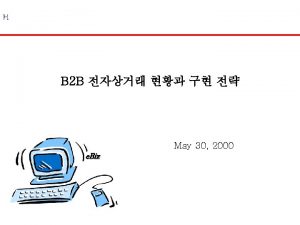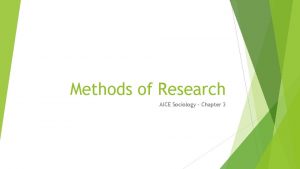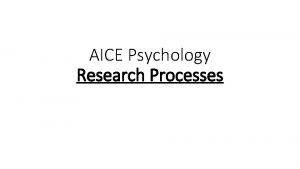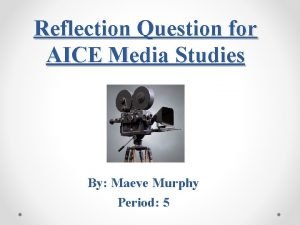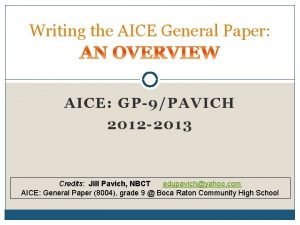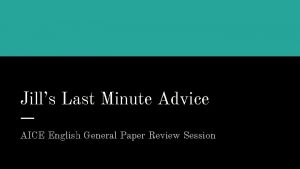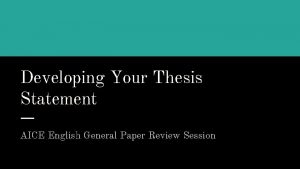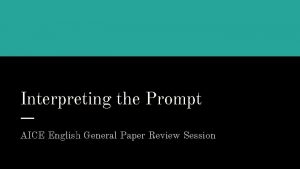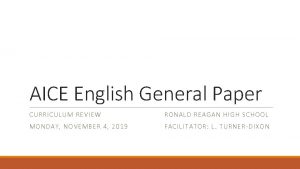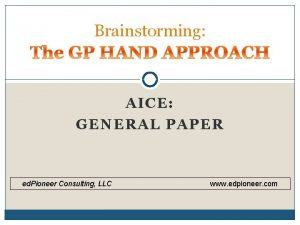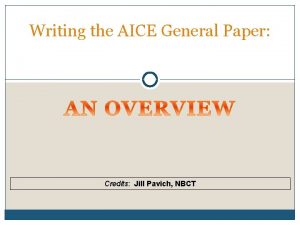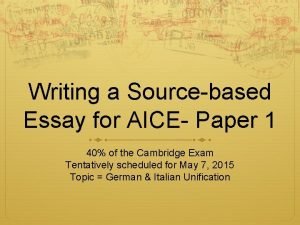AICE English General Paper An Overview of the







![Marking - Paper 1: Level 5 - [25 -30 marks] ● Must give consideration Marking - Paper 1: Level 5 - [25 -30 marks] ● Must give consideration](https://slidetodoc.com/presentation_image_h2/aa00e67680787e1e9c7522e875973c84/image-8.jpg)













- Slides: 21

AICE English General Paper An Overview of the Exam & Scoring

The Exams In May, you will take two sections of the exam, known as “Paper 1” and “Paper 2. ” Paper 1 is the essay, which you will take first. Paper 2 is the Reading Comprehension section, which you will take a few days later, depending on the testing schedule. You will take both sections of the exam in the gym in the beginning of May.

Paper 1: The Essay For this essay, you will be given ten prompts. You must choose one of these prompts and write a well-planned, organized, insightful essay in EITHER an argumentative or discursive style. Your essay must include concrete examples that support your main points, and must be as free as possible of any and all grammatical errors. It must be from 600 -700 words. All the content within your essay must come from your own knowledge, as you will be given no sources. You will have 1 hour and 15 minutes to plan, write,

Paper 1: The Essay You will be given a grade of A, B, C, D, E or U. The ONLY failing grade is the “U, ” which means “Unscorable. ” A U grade means the paper was MUCH too short to score, completely disorganized, full of grammatical errors, and/or the handwriting was so bad that the examiners couldn’t read it. Your letter grade is a COMBINATION of your essay score and your reading score, so you must do well in BOTH categories to receive a high letter grade. Essays are also scored (or “marked” in Cambridge parlance) by levels. Level 5 is the BEST- it’s what you want! Level 1 is the WORST. This is what you want to avoid.

Marking- Paper 1: Worth 30 marks Level 5: 25 - 30 marks…………………. A? Level 4: 19 - 24 marks…………………. B? Level 3: 13 - 18 marks…………………. C? Level 2: 7 - 12 marks…………………. . . D? Level 1: 6 and below…………………. E? Now, even though no one has TOLD me this, and I’m not sure this is the FACTUAL case, it stands to reason to ME that level 5 would be A, 4 would be B, and so on.

Marking- Paper 1: Worth 30 marks (Essay) (page 9) AO 1: Select and apply information - 20% of your score (~6 marks) AO 2: Analyze and evaluate information - 35% of your score (~10. 5 marks) AO 3: Communication in written language - 45% of your score (~13 marks) This means that CLEAR COMMUNICATION and GOOD GRAMMAR is the most heavily weighted category for paper 1!!! IN THE PAST, students had to write TWO essays, and there was NO reading. Each essay was worth 50 marks, with a total of 100. So 25/50 on EACH essay was okay, since about 38 -42 was still PASSING. But the grading thresholds change EVERY YEAR, and since the test was NEW last year we DON’T REALLY KNOW how many marks you need to pass each section!

Stats from 2017 -2018 School Year 113 Students took the exam during the 2017 -18 school year. (192 took it last year, and as soon as I get the stats, I’ll give them to you) 6 students got an A (All mine! I’m very proud!) 29 students got a B 29 students got a C 24 students got a D 7 students got an E 21 students got a U
![Marking Paper 1 Level 5 25 30 marks Must give consideration Marking - Paper 1: Level 5 - [25 -30 marks] ● Must give consideration](https://slidetodoc.com/presentation_image_h2/aa00e67680787e1e9c7522e875973c84/image-8.jpg)
Marking - Paper 1: Level 5 - [25 -30 marks] ● Must give consideration to multiple perspectives. (This is where you narrow your scope in the intro!) ● Must answer ALL parts of the prompt. (Read the prompt CAREFULLY!) ● Must use RELEVANT examples and CONNECT them to the points! ● Must develop, analyze, evaluate, and link information! (Output!) ● Must arrive at a well-reasoned judgement. (Pick a side!)

Paper 1: The Essay I know this may seem intimidating, since you are used to writing essays for the FSA and Palm Beach Writes, which include sources and are a different animal, but during the course of this class we will be covering a wide range of topics as well as writing skills so that you will be prepared. However, since the prompts can cover just about everything, it would also be IN YOUR BEST INTEREST to be proactive by paying attention in your other classes, watching the news, writing timed practice essays at home, and READING

Paper 2: Reading Comprehension Last year was the first year of the new exam, so it was the first year that a reading comprehension portion was introduced. All my kids last year said this part was easy, but that makes me nervous! The most important things to remember about this section are to READ THE QUESTIONS CAREFULLY and understand HOW AICE wants you to ANSWER the questions, since it’s different from what you have been taught in the past.

Marking- Paper 2: Worth 50 marks - There are TWO sections: Section A (Logic) and Section B (Prose). - EACH section is worth 25 marks. So the LOWEST we THINK you can get in order to earn an E is a 12 -14 in EACH section. In PAST exams with reading comprehension sections 23/50 was an E. - One GOOD piece of news about this section is that GRAMMAR is NOT as heavily weighted here. They will NOT be very picky about grammar (spelling, punctuation, etc) but they WILL be picky about CLARITY. They want to see if you can CLEARLY communicate your message. If your meaning is understandable, you’ll be fine. If they don’t “get it” because you’re not CLEAR, you WON’T be fine. WHY? Did you know that only 10% of candidates who take the EGP exam each year are native English speakers? You get a break here! (Those of you who speak

Paper 2 - Reading Comp, Section A: Logic and Reason In this section, you’ll be given a scenario and you must answer questions using the information given, along with logic, reason, and evidence. For example, you might be told you are a mayor of a city, and you must choose a project to fund. They will give you three projects, and information about those projects. Then you must answer questions like what the best choice is, what the worst choice is, etc. There are no 100% “wrong” answers, but you MUST argue and support your points. Let’s look at an example we will use for practice later on. Turn to page 58.

Paper 2 - Reading Comp, Section B: Prose “Prose” just means is so-called "ordinary writing" — made up of sentences and paragraphs, without any metrical (or rhyming) structure. This section could be made up of anything- a story, a set of emails, an article, etc. The questions you must answer will be based on comprehension, and involve skills such as inferencing, summarizing, paraphrasing, finding main ideas, drawing conclusions, examining options, and offering opinions. (These are ALL skills you have been taught in English classes throughout your educational life, and skills that are tested on the FSA as well!) Let’s look at another example. Look on page 31.

Paper 2 - Reading Comp, The Marks Notice that after each question, there is a number in brackets. These are the number of “marks” (or points) each question is worth. This number will ALSO tell you about how many words, AND how many ideas you need to include in your answer. The general rule of thumb is ten words for every mark. So, a 2 mark question should be about 20 words, an 8 mark question should be about 80 words, etc. There is a five word window, but in this case the examiners will be looking for CONCISE answers, so you DO NOT want to write 50 words for a 2 mark question! Last year, my students and myself had the most trouble with getting the word count DOWN in our responses.

Marking- Paper 2: Longer Reponses We already know the word count relates to the marks. But another aspect to consider is how many points/ideas/pieces of evidence (P/I/E) they want you to bring up in the longer responses. This is the general breakdown: Marks: How many p/i/e: Words: 10 4 -5 100 8 3 -4 80 6 3 60 4 2 40 Basically you can cut the marks in HALF when it comes to P/I/E. But if you have 3 strong, well developed points for an 8 mark question, for example, you’ll still be okay. Keep in mind, if the questions SPECIFICALLY asks for a certain NUMBER of P/I/E (advantages or disadvantages, for example) then FOLLOW WHAT THE QUESTION SAYS!!!

Nuance of Language- Paper 2 In the longer response questions for paper 2 they will be looking at how you ANALYZE the content you read. They will be looking for phrases like: This seems to suggest… This assumes that… This seems to indicate that… It can be assumed that… Due to X, it stands to reason that Y because Z. Because of X, it can be assumed that Y. X indicates Y, which means Z. It appears that…

Five Common Question Types in Paper 2 1. “ Right There” questions. These will be the questions worth fewer marks - those that ask you to locate information that is explicitly stated in the text. The command words will most likely be “Identify” or “Give”. The keys to these will be to make sure you’re not restating the question and to make sure you’re not using the exact words that the text does. 2. Imply/Infer questions. These will have you explain what the text says and show you understand the implication of this. These may be phrased like “Based on what the text says in paragraph 3, explain what you think is meant by…” Combo 1 & 2: “What did Mr. X say in paragraph 4 and what does that imply? ”

Five Common Question Types in Paper 2 3. Language related questions. Synonyms: “In paragraph 3 the text it says X. What is another way to say X? ” OR “What phrase in the text means the same as X? ” Words in context: Vocabulary. Defining a word AS IT IS USED IN THE TEXT and then USING that word correctly in your own sentence. READ DIRECTIONS CAREFULLY! 4. Summarize/Paraphrase questions. You need to show understanding of the text IN YOUR OWN WORDS. Questions will sometimes even remind you of this by saying “In your own words as far as possible…”

Five Common Question Types in Paper 2 5. Take a position questions. These involve writing persuasive text and will be seen in section A (logic). Here you will have to assert your claim AND back it up with info from the text AND/OR your own ideas/lmowledge. (Again, READ INSTRUCTIONS CAREFULLY!) The key will be to stick to your position! These will most likely tell you to “restrict your answer to the chosen option” so you CANNOT compare your choice to other options. IF it DOESN’T say that, then and only then can you discuss the other choices. You will have to JUSTIFY your choice! Look again at the example on page 58.

What does “justify” mean? Definition: (verb) show or prove to be right or reasonable. This is like proving your point. When it asks you to justify your answer or choice, it’s asking you to prove that you’re right by explaining how and/or why. This means giving reasons to support your answer. When a prompt asks something like “Is child labor ever justified? ” or “Is breaking the law ever justified? ” it is asking if there is EVER a situation where child labor or breaking the law is REASONABLE. When you are talking about if something is or isn’t justified, you would NEVER say something “should” or “shouldn’t” be justified. Either it IS reasonable or it ISN’T.

What questions do you have? Are ya scared yet?
 Aice english paper 2
Aice english paper 2 Aice general paper essay
Aice general paper essay General paper tips
General paper tips Aice general paper
Aice general paper Aice gen paper
Aice gen paper Aice general paper hand approach
Aice general paper hand approach Hand approach general paper
Hand approach general paper English language paper 1 2021 june
English language paper 1 2021 june Aice travel
Aice travel Aice environmental management paper 3
Aice environmental management paper 3 General overview
General overview Aice diploma requirements florida
Aice diploma requirements florida Aice sociology
Aice sociology Magellan circumnavigates the world
Magellan circumnavigates the world Aice
Aice What is aice psychology
What is aice psychology Aice essay format
Aice essay format Aice environmental management
Aice environmental management Aice media studies final project
Aice media studies final project Marine science chapter 1
Marine science chapter 1 Aice biology
Aice biology Darwin-dana-daly theory
Darwin-dana-daly theory


